Your kitchen countertops serve as both the functional heart and visual centerpiece of your cooking space, making them one of the most important decisions in any kitchen renovation. With countertops representing a significant portion of your kitchen budget—often $1,872 to $4,429 for average installations—choosing the right material requires careful consideration of durability, maintenance, style, and cost. The choice of countertop surface directly impacts both the functionality and aesthetics of your kitchen, influencing how your space looks, feels, and performs day to day.
The countertop market offers an overwhelming array of options, from traditional natural stones like granite and marble to modern engineered surfaces like quartz and porcelain. Each material brings unique benefits and challenges, whether you’re prioritizing low maintenance, heat resistance, or luxury aesthetics. This comprehensive guide will help you navigate the best kitchen countertops available today, providing detailed insights into costs, performance, and practical considerations for every budget and lifestyle.
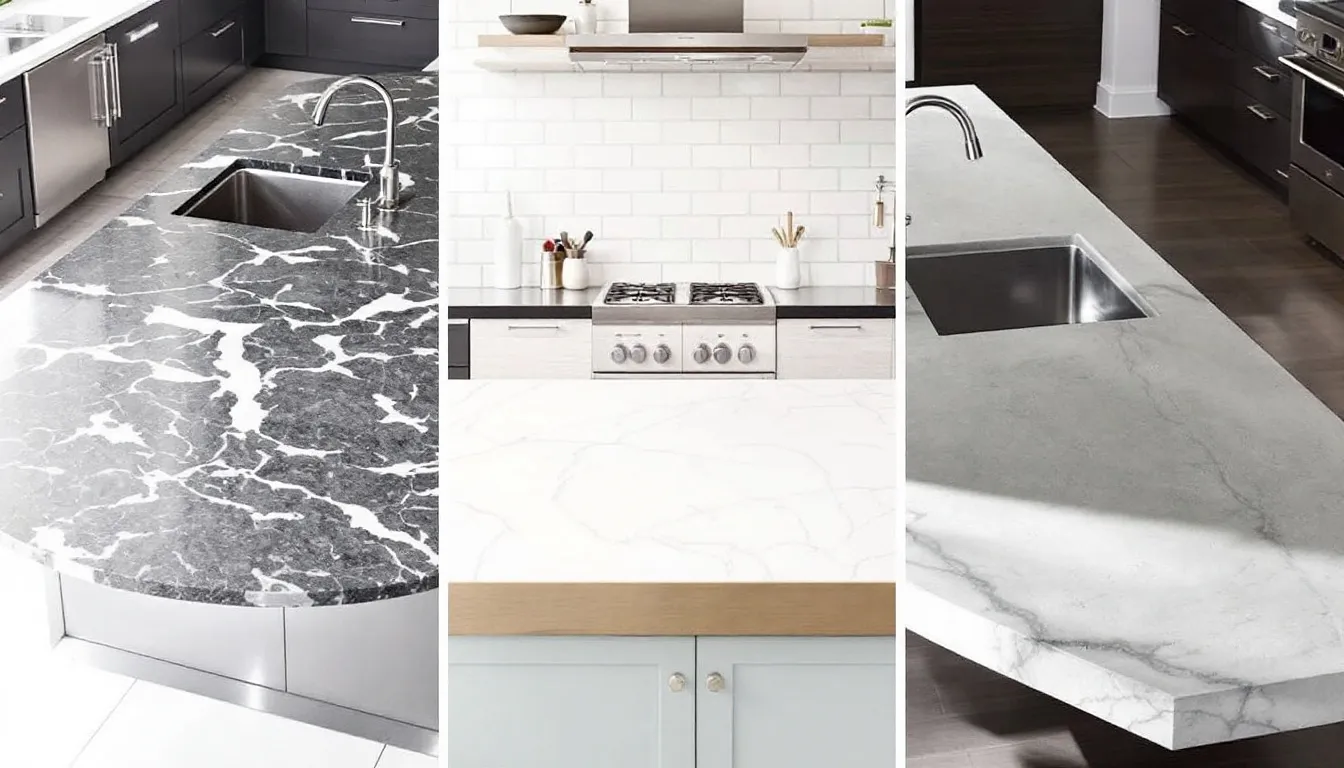
Introduction to Kitchen Countertops
Kitchen countertops are the foundation of both your kitchen’s functionality and its visual appeal. As one of the most frequently used surfaces in the home, your kitchen countertop must stand up to daily food prep, spills, and cleaning, while also complementing your overall kitchen design. With so many types of countertops available, from classic granite countertops to sleek quartz countertops and affordable laminate options, choosing the right material can feel overwhelming.
Popular kitchen countertop materials each bring their own strengths to the table. Granite countertops are celebrated for their incredible durability and heat resistance, making them a favorite for busy kitchens where hot pots and pans are common. Quartz countertops, on the other hand, offer a non-porous, stain resistant surface that requires minimal maintenance—perfect for families seeking both style and convenience. Marble countertops add a touch of luxury and timeless elegance, while laminate countertops provide an affordable alternative with a wide range of styles and colors.
Understanding the unique characteristics, maintenance needs, and style options of each material is essential for selecting the best kitchen countertop for your space. Whether you prioritize low maintenance, a specific look, or long-term durability, there’s a countertop material to suit every kitchen and lifestyle.
Top Kitchen Countertop Materials for 2024
The kitchen countertop landscape has evolved dramatically over the past decade, with engineered materials gaining significant market share while natural stones maintain their appeal. Understanding which materials dominate the market can help guide your decision-making process.
Quartz countertops have emerged as the clear market leader, accounting for over 40% of residential kitchen countertop installations by 2021. This engineered stone combines natural quartz crystals with resin to create a non-porous surface that delivers exceptional durability without the maintenance requirements of natural stone. Its consistent patterns and extensive color options make it appealing to homeowners seeking both performance and aesthetics.
Granite countertops remain a classic favorite, valued for their natural beauty and impressive heat resistance. Each granite slab offers completely unique patterns and mineral compositions, creating one-of-a-kind installations that can dramatically enhance kitchen design. Despite requiring periodic sealing, granite’s proven durability and timeless appeal keep it among the most popular countertop materials.
Marble countertops represent the luxury segment, offering unmatched elegance with their distinctive veining and naturally cool surface. While marble requires more careful maintenance than other natural stones, its association with high-end design and superior baking performance makes it a sought-after choice for serious home cooks and design enthusiasts.
Quartzite has gained recognition as a premium natural stone that bridges the gap between marble’s beauty and granite’s durability. This metamorphic stone provides the dramatic veining patterns reminiscent of marble while delivering superior scratch and heat resistance, making it an attractive option for homeowners who want natural stone aesthetics with enhanced performance.
These four materials dominate the market because they each offer distinct advantages: quartz for low maintenance, granite for natural durability, marble for luxury appeal, and quartzite for the best of both natural beauty and strength. Choosing premium countertop materials like quartz, granite, marble, or quartzite can also add resale value to your home, as buyers often prioritize high-quality surfaces when evaluating properties.
Quartz Countertops
Quartz countertops represent the pinnacle of engineered stone technology, combining approximately 90-95% natural quartz crystals with polymer resins and pigments under extreme pressure. This manufacturing process creates an incredibly durable, non-porous surface that has revolutionized kitchen design by offering the appearance of natural stone without traditional maintenance concerns.
The engineered stone composition makes quartz countertops completely non-porous, eliminating the need for periodic sealing that natural stones require. This characteristic makes quartz highly resistant to stains, bacteria, and moisture penetration, creating an inherently hygienic surface ideal for food prep areas. The consistent manufacturing process also allows for uniform patterns and colors that natural stones cannot match.
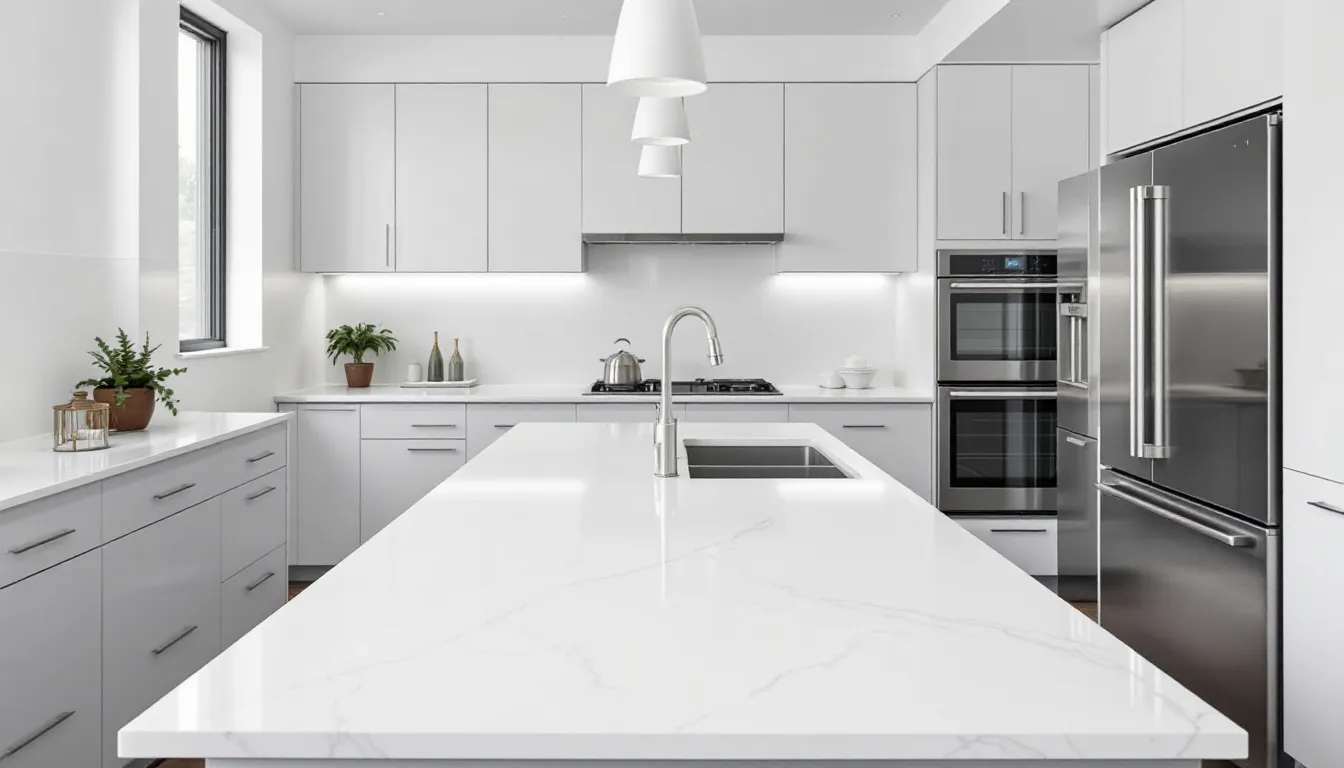
Installation costs for quartz countertops typically range from $55 to $125 per square foot, including professional installation. This price point reflects both the material’s premium performance characteristics and the specialized fabrication required. The investment often proves worthwhile given quartz’s exceptional longevity and minimal maintenance requirements over time.
The color and pattern options available in quartz have expanded dramatically, with manufacturers now offering hundreds of choices ranging from solid colors to realistic stone patterns. Advanced manufacturing techniques can replicate the appearance of marble, granite, and even concrete, providing design flexibility that allows quartz to complement virtually any kitchen style from modern to traditional.
For residential kitchens, quartz delivers outstanding stain resistance and scratch resistance, making it particularly well-suited for busy families. The surface remains consistently beautiful without the patina development that occurs with some natural stones, maintaining its original appearance throughout years of daily use.
Quartz Pros and Cons
The advantages of quartz countertops make them the preferred choice for many homeowners prioritizing convenience and performance. The non-porous surface provides exceptional stain resistance, never requiring sealing like natural stone surfaces. This characteristic also makes quartz incredibly hygienic, as bacteria cannot penetrate the surface, making cleanup simple with basic soap and water.
Consistency represents another significant advantage, as quartz patterns remain uniform across slabs, making it easier to achieve seamless installations across large kitchen spaces. The consistent patterns also mean you won’t encounter the natural variations that can sometimes complicate matching in natural stones. Additionally, quartz typically adds strong resale value to homes, as potential buyers appreciate the low maintenance requirements.
However, quartz does have limitations that buyers should understand. Heat resistance is the primary concern, as quartz can experience thermal shock from extremely hot cookware placed directly on the surface. While the material can withstand normal cooking temperatures, hot pots and pans should be placed on trivets or cutting boards to prevent potential damage.
The upfront cost can be substantial, particularly for premium patterns that mimic exotic natural stones. Professional installation is always required due to the weight and specialized cutting tools needed, adding to the overall investment. Some homeowners also find that quartz lacks the authentic character and natural variation that makes natural stones unique.
Quartz proves ideal for busy families who want a beautiful, stone-like appearance without ongoing maintenance obligations. It’s particularly suitable for households with children, frequent entertaining, or anyone who prefers a “set it and forget it” approach to kitchen surfaces.
Granite Countertops
Granite countertops have maintained their position as a premium kitchen countertop material for decades, prized for their natural beauty, exceptional durability, and impressive heat resistance. As a natural stone formed deep within the earth through intense heat and pressure, granite offers completely unique patterns and color variations that make each installation one-of-a-kind.
The natural stone composition of granite consists primarily of quartz and feldspar minerals, creating a surface with a Mohs hardness rating of 6-7, making it highly resistant to scratches and everyday wear. This natural durability allows granite to withstand decades of use while maintaining its beauty, explaining why many granite installations from the 1990s still look excellent today.
Installation costs for granite countertops typically range from $50 to $150 per square foot, with rare or exotic varieties commanding higher prices. The wide price range reflects differences in stone rarity, origin, thickness, and edge treatment options. Domestic granite varieties often cost less than imported stones, while exotic colors with dramatic patterns can reach premium pricing levels.
The heat resistance of granite makes it particularly appealing to serious cooks who frequently use hot cookware. Unlike engineered surfaces, granite can typically handle hot pots placed directly on the surface without damage, though using trivets remains a recommended practice to preserve the finish.
Each granite slab displays unique mineral patterns, veining, and color variations that create natural artwork in your kitchen. This characteristic means that no two granite installations are identical, providing a custom appearance that many homeowners value. Granite is a popular choice for custom countertops, as it allows homeowners to tailor their kitchen design with one-of-a-kind surfaces that fit specific size, style, and material preferences. The natural variations also mean that granite can hide minor imperfections or normal wear better than uniform manufactured surfaces.
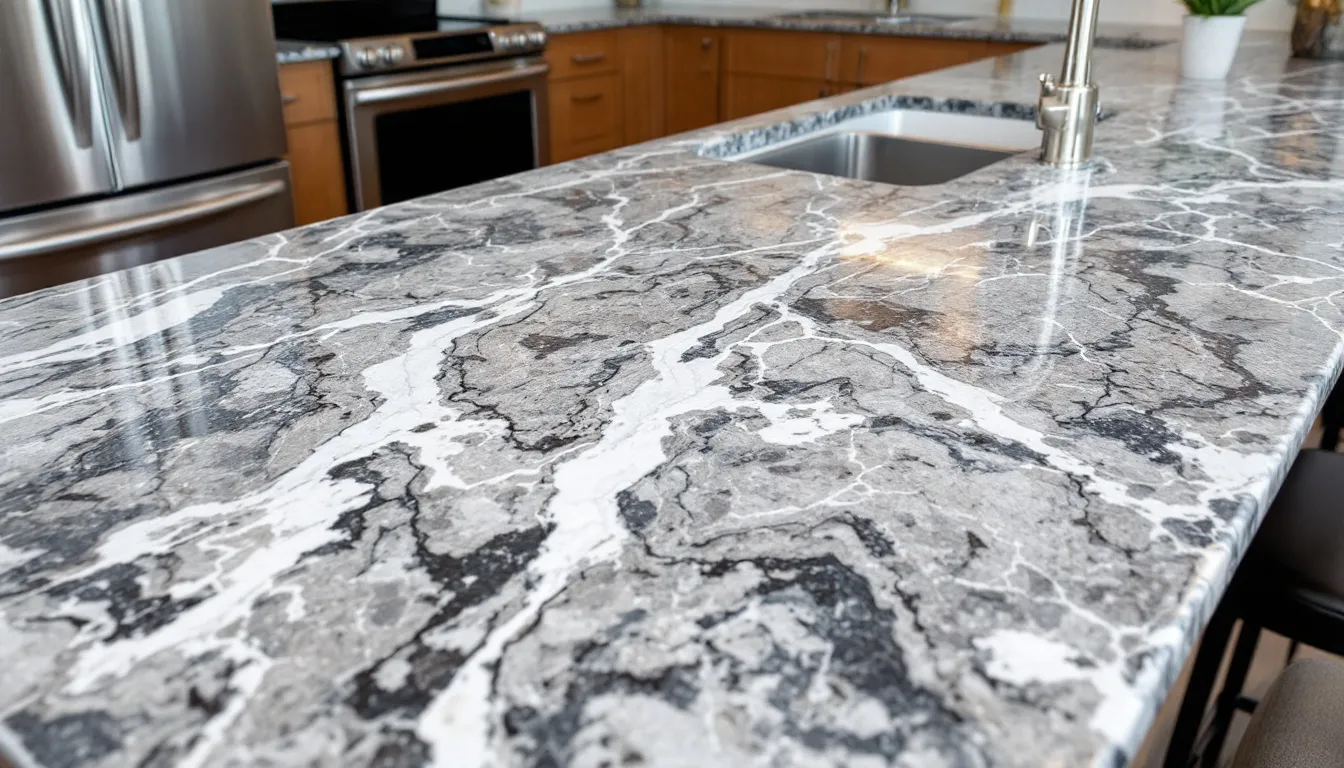
Granite Maintenance and Care
Proper maintenance ensures that granite countertops retain their beauty and performance for decades. The primary maintenance requirement involves periodic sealing to maintain the stone’s stain resistance and prevent bacterial penetration into the natural stone material. Most granite installations require resealing every 1-2 years, though the frequency depends on the specific granite type and usage patterns.
Annual sealing is typically sufficient for most residential kitchens, though you can test whether sealing is needed by placing a few drops of water on the surface. If the water beads up, the seal remains effective. If water absorbs into the stone within a few minutes, it’s time to reseal. The sealing process is straightforward and can be completed by homeowners using appropriate stone sealers.
Daily cleaning should involve mild soap and water, avoiding acidic cleaners that can potentially etch the surface over time. Products containing vinegar, lemon juice, or other acids should be cleaned up immediately to prevent potential etching, particularly on lighter-colored granite varieties. Commercial stone cleaners provide the safest cleaning option for maintaining granite’s natural luster.
Minor chips and scratches can often be professionally repaired, making granite a repairable surface unlike some manufactured alternatives. Professional stone restoration can address most damage, from minor scratches to larger chips, often making repairs virtually invisible.
Using cutting boards protects both your knives and the granite surface. While granite won’t easily scratch, it can dull knife edges quickly, making cutting boards beneficial for both the stone and your kitchen tools. This practice also prevents potential staining from foods that might temporarily discolor the surface.
Marble Countertops
Marble countertops represent the pinnacle of luxury in kitchen design, offering unmatched elegance through their distinctive veining patterns and naturally luminous surface. This metamorphic limestone has been prized for centuries in architecture and sculpture, bringing that same timeless beauty into modern kitchens through varieties like Carrara, Calacatta, and Statuario marble.
The naturally cool surface of marble makes it particularly valuable for serious bakers and pastry enthusiasts. The stone’s thermal properties help keep dough and pastry at optimal temperatures during preparation, explaining why professional bakeries often choose marble work surfaces. This practical benefit combines with marble’s aesthetic appeal to create functional luxury.
Installation costs for marble countertops typically range from $75 to $250 per square foot, with premium varieties like Calacatta commanding the highest prices due to their rarity and dramatic veining. The significant investment often proves worthwhile given marble’s substantial impact on home resale value, as potential buyers immediately recognize marble as a premium feature.
Popular marble varieties each offer distinct characteristics. Carrara marble, quarried in Italy, provides subtle gray veining on a white background and represents the most accessible luxury marble option. Calacatta marble features more dramatic, bold veining patterns and a whiter background, making it the choice for statement installations. Statuario marble offers the most striking appearance with prominent gray veining that creates dramatic focal points. For those seeking the look of marble at a lower price point, marble tiles are a cost-effective and stylish alternative to full marble slabs, allowing homeowners to enjoy the beauty of marble in a more budget-friendly way.
The unique veining in marble results from mineral impurities present during the stone’s formation, meaning each slab displays completely individual patterns. This natural variation creates artistic installations that serve as focal points in kitchen design, though it also requires careful slab selection to achieve desired aesthetic results.
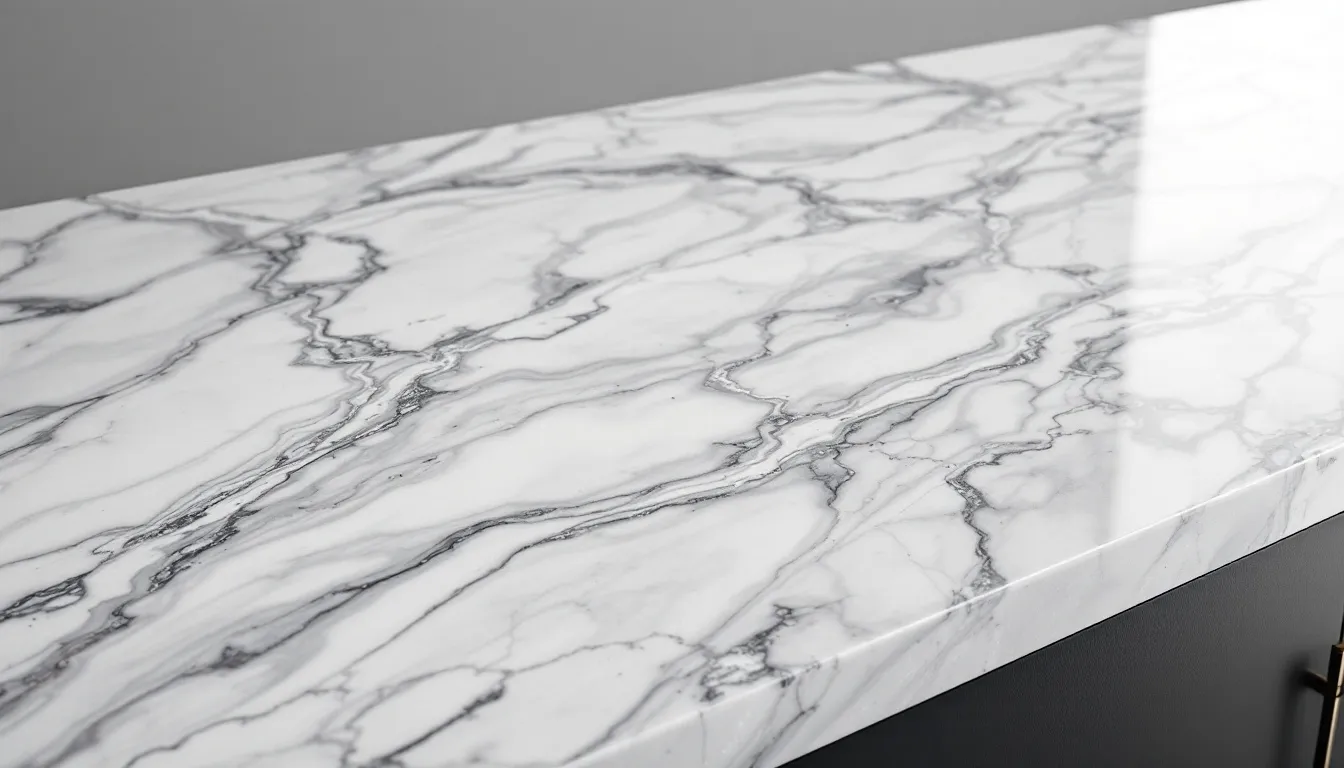
Marble Considerations
Understanding marble’s characteristics is essential for homeowners considering this luxury natural stone. Marble’s porosity and softness (typically Mohs hardness of 3-5) make it more vulnerable to etching and staining than harder stones like granite or quartz. Marble countertops can stain easily, as their porous surface absorbs spills, so prompt cleanup is necessary to avoid permanent stains. Acidic substances like lemon juice, vinegar, or wine can cause permanent etching that appears as dull spots on the polished surface.
The porous nature of marble means that spills must be cleaned immediately to prevent staining. Red wine, coffee, oils, and other deeply colored liquids can penetrate the stone if left on the surface, creating permanent discoloration. However, many marble enthusiasts embrace these characteristics as part of the stone’s natural aging process.
Regular sealing helps protect marble from stains, though it cannot prevent etching from acidic substances. Most marble installations require sealing every 6-12 months to maintain optimal stain resistance, making it a higher maintenance option than harder stones. Professional sealing ensures proper coverage and maximum protection.
Over time, marble develops a natural patina that many owners find appealing. This gradual change in appearance reflects the stone’s interaction with daily use, creating a lived-in elegance that can enhance rather than detract from the kitchen’s character. Some homeowners specifically choose marble for this evolving beauty.
Marble proves ideal for serious bakers who value its functional benefits and homeowners who appreciate natural materials that develop character over time. It’s particularly suitable for those who view their kitchen as an artistic space and don’t mind the additional care required to maintain its beauty.
Wood Countertop Options
Wood countertops, especially butcher block countertops, bring a natural warmth and inviting character to any kitchen. Butcher block is crafted from strips of wood—often maple, oak, or walnut—bonded together to create a sturdy, food-safe surface that’s ideal for kitchen islands and prep areas. These wood countertops are not only beautiful but also eco friendly, as they can be sourced from sustainable forests and are fully renewable.
One of the standout benefits of butcher block and other wood countertops is their ability to be refinished or repaired if scratched or stained. With proper maintenance, such as regular oiling and prompt cleanup of spills, wood countertops can last for decades and develop a rich patina over time. While they do require more care than stone or quartz surfaces—being susceptible to staining and scratching—their repairability and timeless appeal make them a favorite for those seeking a cozy, traditional kitchen design.
Wood countertops also offer design flexibility. They can be paired with granite or quartz countertops to create a custom, multi-material kitchen that balances durability with natural beauty. Whether you choose a full butcher block countertop or use wood as an accent, this material adds a unique, eco friendly touch to your kitchen.
Additional Countertop Materials
Beyond the most popular options, several specialized countertop materials offer unique advantages for specific applications and design preferences. These alternatives provide solutions for homeowners seeking particular performance characteristics or aesthetic goals that mainstream materials might not fulfill.
Soapstone countertops, priced between $60-$150 per square foot, offer a distinctive matte finish and exceptional durability. Composed primarily of talc, chlorite, and magnesite, soapstone is naturally non-porous, eliminating the need for sealing while providing superior heat resistance. The material naturally develops a patina over time, creating a lived-in appearance that many homeowners find appealing. Soapstone’s naturally antibacterial properties make it particularly suitable for food prep areas.
Porcelain slab countertops represent cutting-edge technology in kitchen surfaces, typically costing $55-$120 per square foot. These ultra-thin slabs are created by firing high-quality clays at extreme temperatures, resulting in extremely durable surfaces that are scratch resistant, heat resistant, and completely stain resistant. Digital printing technology allows porcelain to mimic virtually any material, from marble to concrete, while maintaining superior performance characteristics.
After discussing solid surface countertops, it’s important to note that Corian countertops are a popular solid surface material made from acrylic. Corian countertops are known for their affordability, wide variety of colors, and low maintenance requirements. They offer design versatility but can be easily scratched and are sensitive to heat, which are important considerations for homeowners.
Butcher block countertops provide warmth and natural beauty at $45-$100 per square foot. These wood countertops create a farmhouse or traditional aesthetic while offering a surface that’s gentle on knives and easily repairable through sanding. However, wood countertops require regular oiling and careful maintenance to prevent water damage and staining.
Concrete countertops offer unlimited customization potential at $65-$130 per square foot. This material can be formed into any shape, embedded with decorative elements, and finished in various textures and colors. The industrial aesthetic appeals to modern design enthusiasts, though concrete requires careful sealing to prevent stains and cracks.
Stainless steel countertops, ranging from $65-$95 per square foot, bring commercial kitchen functionality to residential spaces. Stainless steel is widely used in commercial kitchens due to its durability, ease of cleaning, and industrial aesthetic, and is now popular in residential kitchens for a similar look. The non-porous surface provides exceptional hygiene and heat resistance, making it ideal for serious cooks. However, stainless steel shows water spots and scratches easily, requiring regular maintenance to maintain its appearance.
Laminate countertops remain a budget-friendly choice, but it’s important to note that laminate surfaces can be easily scratched compared to more durable materials.
Homeowners looking to refresh their kitchens can update or transform existing countertops using affordable, DIY-friendly solutions such as contact paper or skim-coat concrete. These methods allow for a new look without the need to replace the entire countertop.
Eco-Friendly Options
Eco-friendly countertops are gaining popularity as homeowners look for sustainable ways to enhance their kitchens without sacrificing style or performance. There are several green countertop materials to consider, each offering a blend of durability, low maintenance, and environmental responsibility.
Recycled glass countertops are made from crushed glass set in a resin or concrete base, resulting in a vibrant, durable surface that’s easy to clean and maintain. These countertops are not only visually striking but also divert waste from landfills, making them a smart eco friendly choice.
Bamboo countertops are another sustainable option, crafted from rapidly renewable bamboo grass. They offer a warm, natural look and are surprisingly durable, though they do require regular sealing to prevent moisture damage.
Concrete countertops can also be made eco friendly by incorporating recycled aggregates and using low-VOC sealers. These stone countertops are highly customizable in color and texture, and when properly maintained, they offer a long-lasting, low maintenance surface.
Natural stone countertops like granite and marble are inherently eco friendly due to their longevity and durability. When properly maintained, these stone materials can last a lifetime, reducing the need for frequent replacements and minimizing environmental impact.
When selecting an eco-friendly countertop, consider not only the source and sustainability of the material but also its durability and maintenance needs. Choosing a surface that stands the test of time is one of the most effective ways to create a greener kitchen.
Budget-Friendly Options
Cost-conscious homeowners have numerous attractive options that provide excellent value without sacrificing style or basic functionality. These affordable alternatives allow for beautiful kitchen updates while preserving budget for other renovation priorities.
Laminate countertops have evolved dramatically from their earlier iterations, now offering sophisticated patterns that convincingly mimic stone and wood at just $10-$40 per square foot. Modern laminate technology creates realistic textures and patterns that can fool even experienced eyes, while new edge treatments eliminate the telltale signs of traditional laminate installations. Some premium laminates now include antimicrobial properties and improved scratch resistance.
Tile countertops provide incredible versatility with costs ranging from $1-$100 per square foot depending on tile selection. Ceramic and porcelain tiles offer durability and easy maintenance, while natural stone tiles provide authentic material at lower costs than solid slabs. The key consideration with tile countertops involves grout maintenance, as grout lines can collect bacteria and stains without proper sealing and cleaning.
Solid surface countertops, such as Corian countertops, provide seamless appearance and repairability at $40-$65 per square foot. These acrylic-based surfaces can be formed into integrated sinks and custom shapes while offering easy maintenance and scratch repair capabilities. While not as durable as stone, solid surface materials provide excellent value for their seamless appearance and customization options.
Pre-cut or prefabricated slabs offer significant cost savings across all material types by eliminating custom cutting and reducing fabrication time. While these standard sizes limit design flexibility, they can reduce costs by 20-40% compared to custom installations. This option works particularly well for standard kitchen layouts without complex cutouts or unusual dimensions.
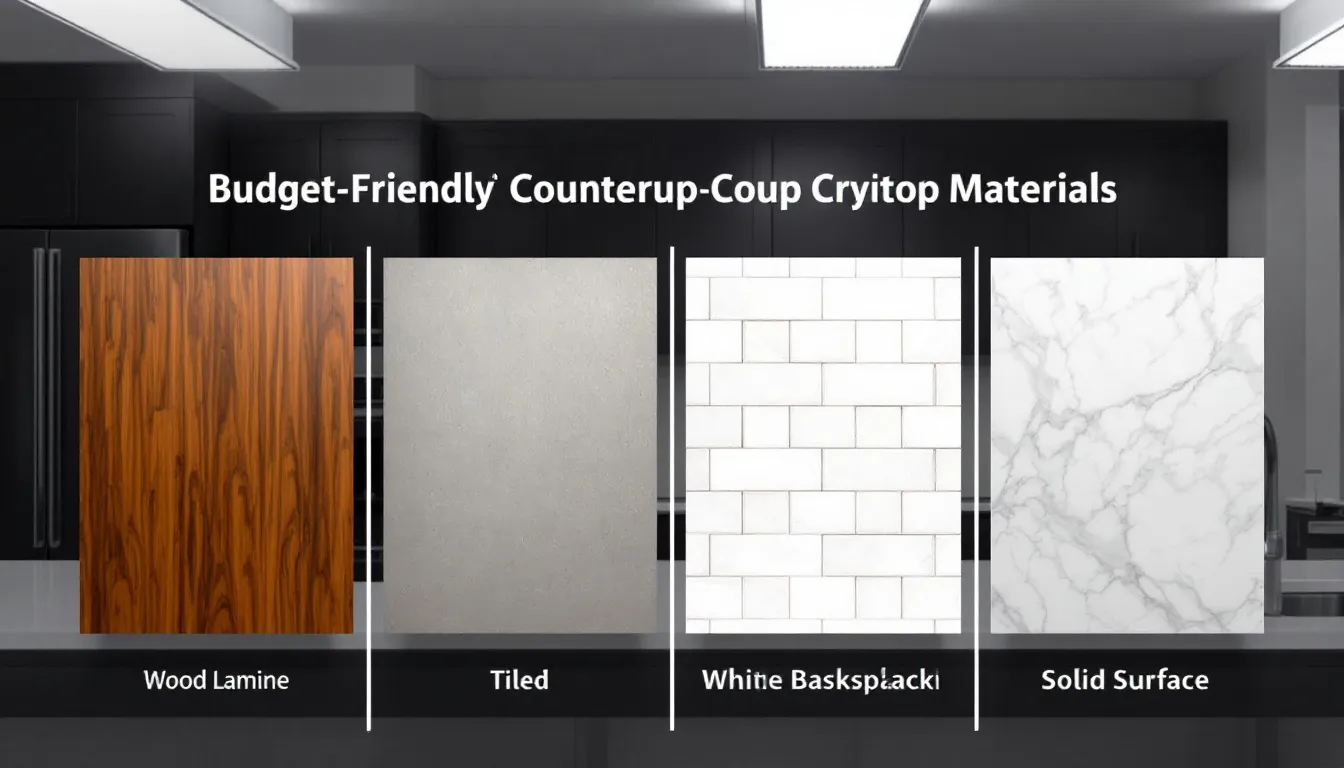
Countertop Styles and Trends
Countertop styles and trends are constantly evolving, offering homeowners a wide range of options to express their personal taste and enhance their kitchen design. Traditional kitchens often feature classic granite or quartz countertops, prized for their timeless appeal and ability to complement a variety of cabinet styles. In contrast, modern kitchens are embracing bold materials like concrete countertops and stainless steel countertops, which deliver a sleek, industrial look and exceptional durability.
Farmhouse and rustic kitchen designs frequently incorporate wood countertops or butcher block, adding warmth and a handcrafted feel to the space. These wood surfaces pair beautifully with painted or natural wood cabinets, creating a cozy, inviting atmosphere.
While popular countertop materials like granite, quartz, and marble remain perennial favorites for their beauty and performance, there’s a growing interest in eco friendly materials and unique textures. Recycled glass, concrete, and even mixed-material countertops are making their way into contemporary kitchens, offering both sustainability and standout style.
When choosing a countertop style, consider how the material’s color, texture, and finish will interact with your kitchen’s overall design. Whether you prefer the classic elegance of marble, the modern edge of stainless steel, or the natural charm of wood, today’s countertop materials make it easy to create a kitchen that’s both beautiful and functional.
Countertop Selection Factors
Choosing the right kitchen countertop material requires evaluating multiple factors that affect both immediate satisfaction and long-term performance. Understanding these considerations helps ensure your investment meets your specific needs and expectations.
Budget considerations extend beyond initial material costs to include installation, maintenance, and potential replacement expenses. While granite countertops cost less upfront than quartz, the ongoing sealing requirements add long-term expenses. Conversely, higher initial investments in low-maintenance materials like quartz often prove economical over time through reduced upkeep costs.
Lifestyle needs significantly impact material suitability. Families with young children benefit from stain resistant surfaces like quartz that can withstand spills and heavy use. Serious cooks might prioritize heat resistance, making granite or soapstone attractive options. Those who entertain frequently might value the luxury appearance of marble despite its maintenance requirements.
Design style preferences help narrow material choices. Modern kitchens often feature clean lines that complement quartz or porcelain surfaces, while traditional designs might call for natural stone materials that provide authentic character. Industrial aesthetics pair well with concrete or stainless steel, while farmhouse styles often incorporate butcher block elements.
The resale value impact varies significantly by material and local market preferences. Natural stone countertops typically add the most value, with granite and marble being particularly appealing to potential buyers. However, regional preferences can influence this impact, making local market research valuable when renovation goals include resale considerations.
Kitchen size and layout constraints affect material selection and costs. Large kitchens require more material and may benefit from consistent patterns available in engineered surfaces. Complex layouts with numerous cutouts or unusual shapes might favor materials that are easier to fabricate, potentially influencing the balance between material cost and installation complexity.
Durability Comparison
Understanding how different materials perform under real-world conditions helps predict long-term satisfaction and maintenance requirements. Laboratory testing and consumer experience provide valuable insights into material performance across various stress factors.
For daily use durability, quartz, granite, and quartzite consistently rank as top performers. These materials resist normal kitchen wear including cutting, chopping, and general food preparation activities. Quartz’s engineered composition provides particularly consistent performance, while granite and quartzite offer natural stone durability with unique character.
Heat resistance varies significantly among materials, with natural stones generally outperforming engineered alternatives. Granite and soapstone can typically handle hot cookware placed directly on the surface, while quartz and other engineered materials require trivets or cutting boards to prevent thermal shock damage.
Scratch resistance testing shows quartz and granite performing exceptionally well under normal use conditions. However, extremely hard materials or deliberate abuse can damage any surface. Softer materials like marble and soapstone can be easily scratched and show scratches more readily, but can often be professionally restored. Laminate surfaces are also easily scratched compared to harder surfaces like quartz and granite.
Stain resistance depends heavily on porosity and sealing. Non-porous materials like quartz and porcelain provide superior stain resistance without maintenance, while properly sealed natural stones offer excellent performance with periodic care. Unsealed natural stones and porous materials like concrete require immediate spill cleanup to prevent permanent staining.
Kitchen Cabinets and Countertops
Achieving a cohesive kitchen design means thoughtfully coordinating your kitchen cabinets and countertops. The right combination of materials, colors, and styles can transform your kitchen into a harmonious and functional space that reflects your personal taste.
For a timeless look, white kitchen cabinets pair beautifully with granite or quartz countertops, creating a bright and airy feel. Wood cabinets, on the other hand, are a natural match for butcher block or wood countertops, enhancing the warmth and organic appeal of the kitchen. If you’re aiming for a modern aesthetic, consider sleek quartz countertops with flat-panel cabinets, or pair stainless steel countertops with bold, contemporary cabinetry for an industrial vibe.
When selecting your kitchen cabinets and countertops, think about how the materials and finishes will work together with your flooring, lighting, and appliances. The goal is to create a unified space where every element complements the others, both in style and function.
Whether you’re designing a traditional, modern, or rustic kitchen, there are endless combinations of quartz countertops, wood countertops, and other materials to suit your needs. By carefully coordinating your kitchen cabinets and countertops, you’ll create a space that’s not only beautiful but also perfectly tailored to your lifestyle.
Installation and Professional Considerations
The installation process significantly impacts both the final appearance and long-term performance of kitchen countertops. Understanding the differences between custom and prefabricated options helps set appropriate expectations for timing, costs, and results.
Custom countertop fabrication involves creating templates from your specific kitchen measurements, then cutting and finishing materials to exact specifications. This process typically requires 2-6 weeks from template creation to installation, depending on material selection and fabricator schedules. Custom work allows for complex edge treatments, integrated sinks, and precise fits around obstacles.
Prefabricated options use standard sizes and shapes to reduce fabrication time and costs. While these options limit customization possibilities, they can often be installed within days of ordering and typically cost 20-40% less than custom work. Pre-cut slabs work best for standard kitchen layouts without complex requirements.
Professional installation is essential for most stone materials due to their weight, specialized cutting requirements, and precision needed for proper fit. Stone slabs can weigh 600-1000 pounds, requiring specialized equipment and experienced teams for safe handling. Professional installers also ensure proper support and sealing that affects long-term performance.
Some materials like laminate, tile, and certain butcher block options allow for DIY installation by skilled homeowners. These projects can provide significant cost savings but require proper tools, techniques, and time investment. Consider your skill level honestly, as mistakes in countertop installation can be expensive to correct.
The template and measurement process requires precision to ensure proper fit, particularly around sinks, cooktops, and other fixtures. Professional templaters use specialized tools to capture exact dimensions and angles, creating patterns that guide the fabrication process. This step is crucial for achieving professional results with custom installations.
Timeline expectations should account for material selection, templating, fabrication, and installation phases. Popular materials during peak renovation seasons may have longer lead times, while complex installations requiring multiple visits can extend the overall timeline. Planning ahead helps avoid delays in your overall renovation schedule.
Maintenance Requirements by Material
Understanding the long-term care requirements for different countertop materials helps ensure lasting beauty and performance while preventing damage that could require costly repairs or replacement.
Low maintenance materials like quartz, porcelain, stainless steel, and laminate require only basic cleaning with soap and water. These non-porous surfaces resist stains and bacteria without special treatments, making them ideal for busy households or those who prefer minimal upkeep. However, each still benefits from appropriate cleaning products and techniques to maintain optimal appearance.
Medium maintenance options include properly sealed granite and solid surface materials. These require periodic attention beyond daily cleaning but don’t demand constant care. Granite needs annual or bi-annual sealing, while solid surface materials benefit from occasional polishing to maintain their luster. Both can handle normal kitchen use with proper care.
High maintenance choices like marble, unsealed natural stones, and butcher block demand regular attention and careful use. Marble requires immediate spill cleanup, frequent sealing, and protection from acidic substances. Wood countertops need regular oiling, careful moisture control, and periodic sanding to maintain their appearance and prevent damage.
Specific cleaning product recommendations vary by material but generally favor pH-neutral cleaners for stone surfaces and appropriate wood treatments for butcher block. Avoiding harsh chemicals, abrasive cleaners, and acidic substances helps preserve surface integrity across all materials. Manufacturer recommendations provide the most reliable guidance for specific products.
Long-term care and refinishing options extend the life of most countertop materials. Stone surfaces can be professionally polished to remove minor scratches and etching, while wood surfaces can be sanded and refinished to address wear and damage. Understanding these restoration possibilities helps evaluate the true lifespan and value of different materials.
The best kitchen countertops for your home ultimately depend on balancing performance requirements, aesthetic preferences, budget constraints, and maintenance willingness. Quartz continues to lead the market through its combination of durability and low maintenance, while natural stones like granite and marble offer unique beauty that many homeowners find irreplaceable. Consider your specific cooking habits, family needs, and long-term goals when making this significant investment in your kitchen’s functionality and appearance.
Whether you choose the consistent performance of engineered materials or the natural character of stone surfaces, proper selection and professional installation ensure years of satisfaction with your kitchen countertop investment.
Contact Us For A Local Countertop Quote
Contact us and we can help decide on your next perfect countertop for your home.
